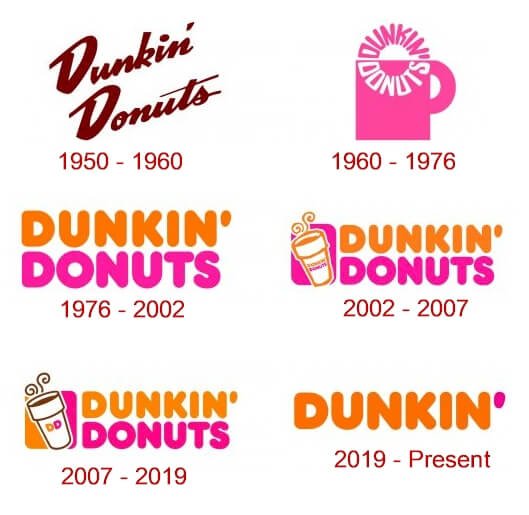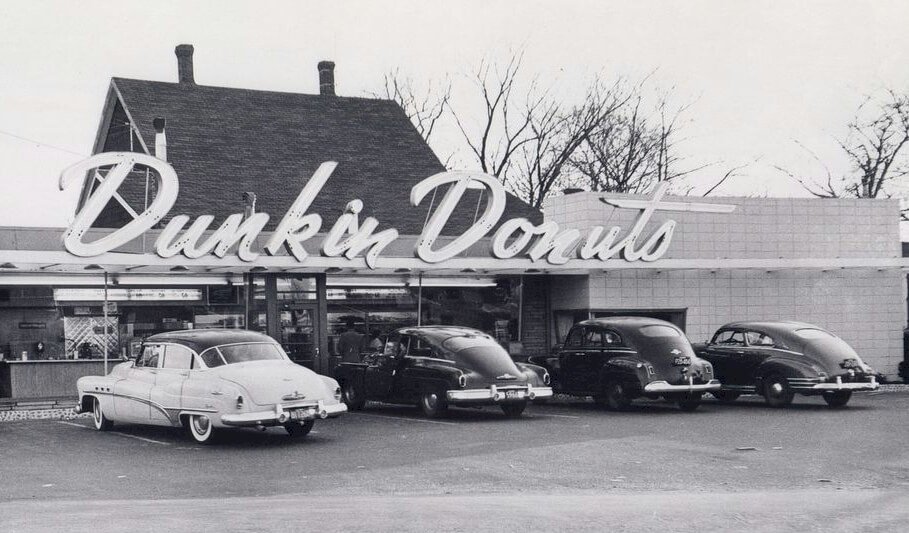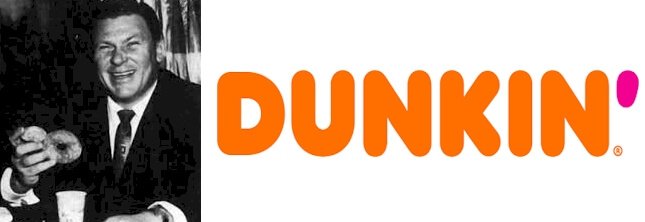The U.S. multinational coffee and donut company Dunkin’ Donuts unveiled its first logo design in 1950 when the company was formed. It was a crimson wordmark written in a handwriting-like cursive script.
This lasted up to 1955 when Dunkin’ Donuts’ mascot Dunkie made his appearance on the company’s logo. The dancing mascot’s body was in the form of a mug, while his legs, hands, and head were in the form of donuts. The 1950 cursive script logo was placed over the mug.
In 1960, Dunkin’ Donuts introduced a new logo featuring a wordmark donut being dipped into a coffee mug. Just a year later, only the circular text remained. Between 1970 and 1976, the Dunkin’ Donuts logo was a combination of a basic text logo and the previous text and coffee cup logo.
The modern-looking Dunkin’ Donuts logo of today was designed in 1976 and has been in use ever since, with minor color adjustments throughout the years.
History and Evolution of the Dunkin’ Donuts Logo

1950
The original Dunkin’ Donuts logo couldn’t be more different from the present one. Both the handwritten script and brown shade are in stark contrast to the plump and cheerful letters we’re so used to.
1960
The family candy pink shade first appeared in 1960 and has never left the emblem. The emblem features a pink cup with a circular wordmark over it. The upper part of the circular wordmark is pink, while the lower white part is inside a pink coffee mug.
The brand name is written to look like a donut dunked in coffee, while the mug symbolizes the fact that Dunkin’ Donuts sells coffee.
1976
In 1976, Dunkin’ Donuts redesigned its logo, replacing the donut and cup with the bright lettering “Dunkin’ Donuts” in two rows. The word “Dunkin’” at the top is written in tinted powdery orange, while “Donuts” is written in candy pink at the bottom.
2002
A coffee mug against a pink background was added to the previous logo design so that customers could instantly understand that they could buy coffee with donuts at Dunkin’ Donuts. The new logo had the image of a steaming coffee mug with the brand’s wordmark placed to the right. Some locations still use this logo today.
2007
In 2007, the logo designers attempted to improve the 2002 version. The new logo featured a revised mug design with the “Dunkin’’ Donuts” wordmark shortened to “D.D.,” while the square background was changed to feature both pink and orange. This version is still in use outside of America (excluding several countries).
2019
In January 2019, the word “Donuts” was dropped from the company’s name to better represent their product range beyond coffee and donuts. Dunkin’ Donuts first used this version at their new Quincy, Massachusetts location in 2018, introducing it the following year. The new brand name will ultimately be introduced in all its overseas stores.
The Dunkin’ Donuts Logo Design Elements

Symbol: The Dunkin’’ Donuts logo first featured the hot pink shade in 1960. The symbol itself portrayed a stylized coffee mug with a circular “Dunkin’’ Donuts” wordmark dunked in halfway. In 1976, orange made its first appearance on the logo. The updated wordmark consisted of the brand name only, written in orange and hot pink.
Apart from the orange and pink wordmark, the current symbol, which was unveiled in 2006, consists of a steaming mug of coffee with a brown outline featuring a “D.D.” monogram.
Color: The mix of orange and hot pink on a white background brings a jolly, happy mood.
Font: The font used for the wordmark looks very much like the Debussy and Frankfurter fonts. The letters appear round and plump to the extent of being mouth-watering, which seems absolutely appropriate for a brand specializing in selling coffee and donuts.
The History of Dunkin’ Donuts
Dunkin’ Donuts is a multinational coffee and donut company that was founded by William Rosenberg in 1950. Rosenberg had dropped out of middle school to help look after his family after they lost their business in the Great Depression era.
A born entrepreneur, Rosenberg reportedly transported an ice block to a racetrack in New Hampshire and made money selling ice chips for $0.1 each, earning $171.00 in a day. After taking on many different jobs—including delivering telegrams for Western Union aged just 14—Rosenberg was employed as an ice cream truck driver when he was just 17. By age 20, he’d risen through the ranks up to management level.
Dunkin’ Donuts is Founded
Dunkin’ Donuts traces its origins back to the Second World War when Rosenberg was a Quincy Shipyards employee. He eventually realized that his fellow employees lacked many options when it came to having their lunch.
After the war, Rosenberg raised a total of $2,500 to launch a company he named Industrial Luncheon Services, which served coffee, donuts, snacks, and sandwiches out of old phone company trucks he’d converted into what everyone now knows as food trucks.
After realizing that coffee and donuts constituted half of his company’s sales in 1948, Rosenberg started a restaurant called Open Kettle in Quincy, Massachusetts, that sold donuts for one nickel and coffee for 10 cents. While the restaurant was an instant success and was grossing more than $5,000 a week, Rosenberg wasn’t content with the company’s name. Therefore, he decided to change it.
Upon noticing that customers tended to dip their donuts in coffee, Open Kettle was rebranded by Dunkin Donuts two years later. Before long, Rosenberg launched Dunkin’ Donuts restaurants all over Massachusetts in towns such as Shrewsbury, Saugus, Natick, and Somerville, where customers could see the bakers making the donuts.
In 1955, Rosenberg opened his first Dunkin’ Donuts franchise in Dedham, Massachusetts, offering 52 donut varieties, enough to offer a different variety every week of the year.
Dunkin’ Donuts had started its 100th restaurant by 1963 and grew to more than 1,000 restaurants by 1979. Currently, there are about 12,900 locations globally, with 3,200 overseas restaurants in 46 countries.
Sometimes, Dunkin’ Donuts carries the same brand as Baskin-Robbins, another franchised brand from the parent company Dunkin Brands, Inc.
Family Succession

Robert Rosenberg, William Rosenberg’s son, became the CEO of Dunkin’ Donuts when the company was really flourishing in 1963. At the time, the company ran operations using Universal Food Systems, which brought a world of confusion to the menu.
At some locations, Dunkin’ Donuts sold sandwiches and burgers, while at others, just a breakfast menu consisting of coffee and donuts. This is out of character for a restaurant chain and, in fact, not good for its reputation. Robert did away with this system, and the locations became independent.
Dunkin’ Donuts then standardized its menu across all locations. It also went ahead to create new offerings unique to the brand. In 1972, the company also introduced donut holes (Munchkins®) to the market.
Not only was this a waste-management and cost-cutting measure, but it was also a smart move that helped boost sales. These little iconic treats are now one of the company’s best sellers. Moreover, Robert also added croissants, bagels, and fresh drinks to the menu.
One of the main drivers of Dunkin’ Donuts’ success was merging with other companies. In 1990, the Rosenberg family sold Dunkin’ Donuts to a British brewing company named Allied Lyons PLC. The new owners also owned Baskin-Robbins, therefore bringing two food chains together.
Today, Dunkin’ Donuts and Baskin-Robbins are found side by side in numerous locations. They also have collaborated on several new menu items, including the Donut Ice Cream Sandwich. Allied Lyons PLC also acquired a rival brand Mister Donut.
Baskin Robbins and Dunkin’ Donuts now operate under a franchising company called Dunkin’ Brands, Inc, which boasts more than 21,000 stores in more than 60 countries.
The Story Behind Dunkin’ Donuts’ Success
Dunkin’ Donuts remains one of the top restaurant chains in the world. It’s renowned for its fresh foods, exciting and fresh donut ideas, as well as innovative marketing strategies. Interestingly enough, Dunkin’ Donuts invented the word “donuts,” which became the new unofficial spelling for “doughnuts.” This even started a spelling debate.
The company sells an average of 6.5 million donuts daily and over 2.9 billion mugs of coffee per year. It’s now the world’s biggest bagels and donuts franchise.
Dunkin’ Donuts has always adopted a friendly tone when it comes to its adverts and campaigns, making many people opt for its coffee over Starbucks due to its pocket-friendly price. The company has also come up with a new concept dubbed on-the-go ordering, which lets customers make an order one day in advance.
Dunkin’ Donuts has always had many celebrities associated with its brand. In fact, Al Pacino was its spokesman at one point. The company made a name for itself, supporting many fundraisers and charities. It also contributes to hospitals and medical research, in addition to donating to cancer organizations.
Dunkin’ Donuts Expansion
- Dunkin’ Donuts introduced a new store layout in 2003, the company’s first in almost seven years.
- In January 2014, Dunkin’ Donuts got back to the United Kingdom market, opening a new restaurant in Harrow, northwest London.
- In May 2004, Dunkin’ Donuts revealed that it planned to start 20 to 25 stores in Finland, the same number of stores in Denmark, as well as 30 other stores in Sweden.
- Dunkin’ Donuts launched its first location in India in November 2014, inside Z Square Mall in Kanpur.
- In September 2015, Dunkin’ Donuts Swiss franchise owner Roland Zanelli announced the launch of approximately 60 stores countrywide. In March 2016, the first store in Basel was opened.
Dunkin’ Donuts Rebranded
Dunkin’ Donuts continues to evolve. In September 2018, the company announced plans to change its branding, shortening the brand name to just Dunkin’.
Through the joint efforts of three branding agencies Arc Worldwide, Knowles Ritchie, and Knowles Ritchie, the new brand name was unveiled in U.S. stores in early 2019. The company retained the pink and orange color scheme, as well as the logo’s font, which were both designed in 1973.
In addition to the change of brand name, the company installed an 8-headed tap setup for cold beverages and doubled down on mobile orders, launching a special drive-thru lane for mobile orders.
Controversies
Like any other renowned restaurant chain, Dunkin’ Donut has also had its fair share of controversies throughout its history. For instance, in 2013, the company got into trouble when it was accused of showing a woman in blackface in an ad that aired in Thailand to promote the company’s chocolate donuts.
To add insult to injury, the Thailand Dunkin’ Donuts CEO didn’t apologize for downplaying the incident as “paranoid thinking of the West,” but the headquarters did apologize later. In 2017, the restaurant chain faced multiple suits, accused of not using organic berries, using beef rather than steak, and using margarine rather than butter.
In 2018, a Baltimore Dunkin’ Donuts chain displayed a sign on its counter asking customers to report workers communicating in any language apart from English. The sign was circulated on social media, and it went viral. Many people were unhappy with the sign and blasted the company for it, calling the move racist.
Dunkin’ Donuts ended up owning up to their mistake and ultimately removed the sign. In addition, there have been multiple allegations of Dunkin’ Donuts throwing away tons of unsold donuts every day instead of giving them away to a food bank.
Summing Up the History of Dunkin’ Donuts
Dunkin’ Donuts LLC, aka Dunkin’, is a U.S. multinational doughnut and coffee company and also a quick-service restaurant. The company was founded in 1950 in Quincy, Massachusetts, by William Rosenberg.
In 1990, Baskin-Robbins parent company Allied Lyons PLC acquired Dunkin’ Donuts. Baskin-Robbins also acquired the Mister Donut food chain and converted it to Dunkin’ Donuts, accelerating the growth of Dunkin’ Donuts in the U.S. that year.
In 2004, Baskin-Robbins and Dunkin’ Donuts became subsidiary companies of Dunkin’ Brands, Inc, based in Canton, Massachusetts. In December 2020, Inspired Brands purchased both Baskin-Robbins and Dunkin’ Donuts.
Dunkin’ Donuts started rebranding as a “drink-oriented company” and was rebranded Dunkin’ in early 2019. While U.S. stores started using the new brand name right away, the rebranding will ultimately be completed in all its worldwide stores.
With about 12,900 locations around the world in 42 countries, Dunkin’ remains one of the world’s leading donut and coffee shops. Its products include coffee, donuts, bagels, and donut holes (Munchkins®).







